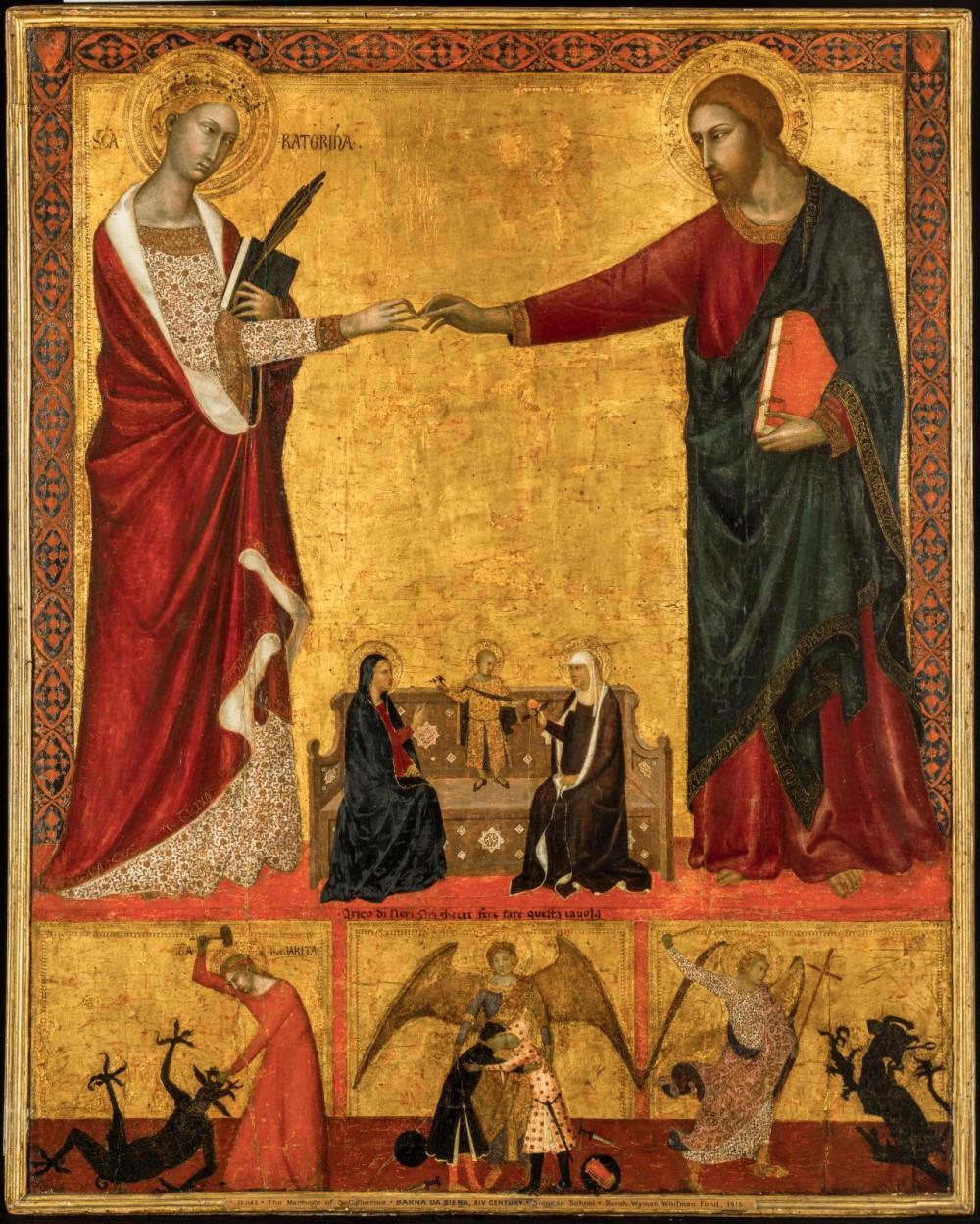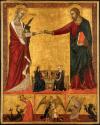Advanced Search
The Mystic Marriage of Saint Catherine
Barna da Siena (Italian (Sienese), active about 1330–1350)
about 1340
Medium/Technique
Tempera on panel
Dimensions
138.7 x 111.1 cm (54 5/8 x 43 3/4 in.)
Credit Line
Sarah Wyman Whitman Fund
Accession Number15.1145
NOT ON VIEW
CollectionsEurope
ClassificationsPanels
The legendary Saint Catherine of Alexandria had a vision in which Christ took her as his spiritual bride, placing a ring on her finger. Here, the union symbolized by this gesture is echoed in two smaller scenes below: Jesus flanked by his mother and his grandmother, Saint Anne; and two enemies reconciled by an archangel, embracing after casting away their weapons. The images of saints Margaret and Michael subduing demons also evoke the triumph of good over evil. It appears that Arigo di Neri Arighetti, named in the inscription, commissioned the painting to commemorate the end of a feud. The identity of the artist remains controversial, but the subtle depiction of the faces and the sinuous lines of the drapery hems make clear that he was inspired by the great Sienese master Duccio.
InscriptionsAbove lower register: ARIGO DI NERI ARIGHETTI FECE FARE QUESTA TAVOLA
ProvenanceAbout 1340, commissioned by Arigo di Neri Arighetti. 1858, Robert Macpherson (b. about 1811/1815 - d. 1872), Rome [see note 1]. 1859, William Blundell Spence (b. 1814 - d. 1900), London [see note 2]. Possibly sold from the collection of Alexander Barker (d. 1873), London to the uncle of Algernon Sartoris [see note 3]; by descent to Algernon Sartoris (b. 1877 - d. 1907), Paris and London; sold by Sartoris to Gimpel and Wildenstein, Paris and New York [see note 4]; 1915, sold by Wildenstein to the MFA for $17,727 [see note 5]. (Accession Date: October 7, 1915)
NOTES:
[1] Robert Macpherson was a Scottish artist who moved to Italy in 1840 and worked as a dealer. Otto Mündler described the painting, which he saw in Rome on May 12, 1858 at the home of Anna Jameson, the aunt of Macpherson's wife ("The Travel Diaries of Otto Mündler," Walpole Society 51 (1985): 234). He did not attribute the painting but said that it was in the style of Simone Martini.
[2] From London, Spence wrote to Lord Alexander William Lindsay on July 27, 1859, offering three paintings that had just arrived from Rome (whether directly from Macpherson is not known), including the MFA painting, attributed to Simone Martini. Lindsay did not purchase it. See John Fleming, "Art Dealing in the Risorgimento," Burlington Magazine 121 (1979): 503, n. 62 and 579, and Hugh Brigstocke, "Lord Lindsay as Collector," Bulletin of the John Rylands Library 64 (Spring 1982): 321, n. 4.
[3] In a letter from Wildenstein, Paris, to Walter Gay of the MFA (December 28, 1915), the painting is said to have been purchased from Sartoris. The dealer believed Sartoris had received it from one of his uncles, who had purchased it from the Barker collection. It cannot be identified with any of the paintings from the Barker auctions of June 6, 1874 or June 21, 1879.
[4] In addition to the information provided by Wildenstein (see above, n. 3), René Gimpel of Gimpel and Wildenstein noted on July 7, 1918, that it had come from the Sartis [sic] collection and been exhibited at the Musée des Arts Decoratifs, Paris as a work by Lorenzo Monaco. See his "Diary of an Art Dealer," trans. John Rosenberg (New York, 1966), p. 46.
[5] Accessioned as a work by Lippo Memmi.
NOTES:
[1] Robert Macpherson was a Scottish artist who moved to Italy in 1840 and worked as a dealer. Otto Mündler described the painting, which he saw in Rome on May 12, 1858 at the home of Anna Jameson, the aunt of Macpherson's wife ("The Travel Diaries of Otto Mündler," Walpole Society 51 (1985): 234). He did not attribute the painting but said that it was in the style of Simone Martini.
[2] From London, Spence wrote to Lord Alexander William Lindsay on July 27, 1859, offering three paintings that had just arrived from Rome (whether directly from Macpherson is not known), including the MFA painting, attributed to Simone Martini. Lindsay did not purchase it. See John Fleming, "Art Dealing in the Risorgimento," Burlington Magazine 121 (1979): 503, n. 62 and 579, and Hugh Brigstocke, "Lord Lindsay as Collector," Bulletin of the John Rylands Library 64 (Spring 1982): 321, n. 4.
[3] In a letter from Wildenstein, Paris, to Walter Gay of the MFA (December 28, 1915), the painting is said to have been purchased from Sartoris. The dealer believed Sartoris had received it from one of his uncles, who had purchased it from the Barker collection. It cannot be identified with any of the paintings from the Barker auctions of June 6, 1874 or June 21, 1879.
[4] In addition to the information provided by Wildenstein (see above, n. 3), René Gimpel of Gimpel and Wildenstein noted on July 7, 1918, that it had come from the Sartis [sic] collection and been exhibited at the Musée des Arts Decoratifs, Paris as a work by Lorenzo Monaco. See his "Diary of an Art Dealer," trans. John Rosenberg (New York, 1966), p. 46.
[5] Accessioned as a work by Lippo Memmi.









